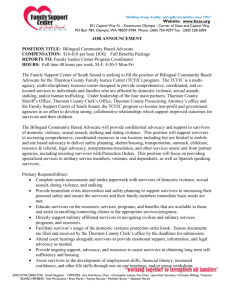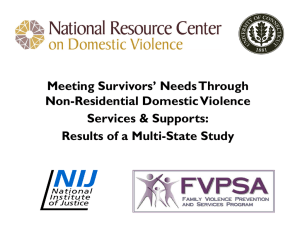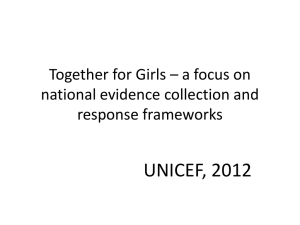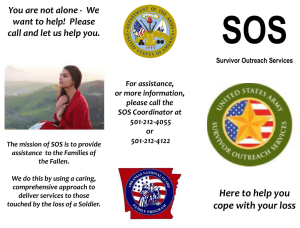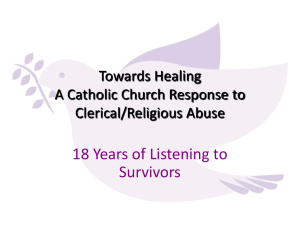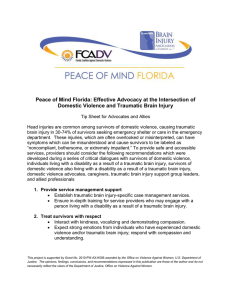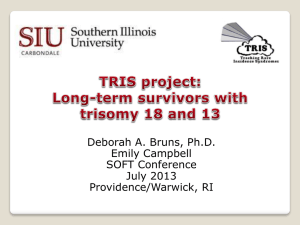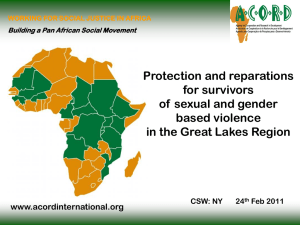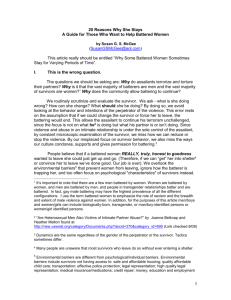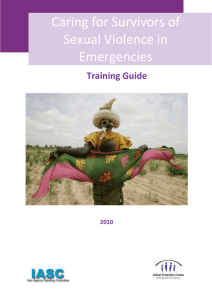ClarkChallengesandResourcesSS11 - DSpace Home
advertisement
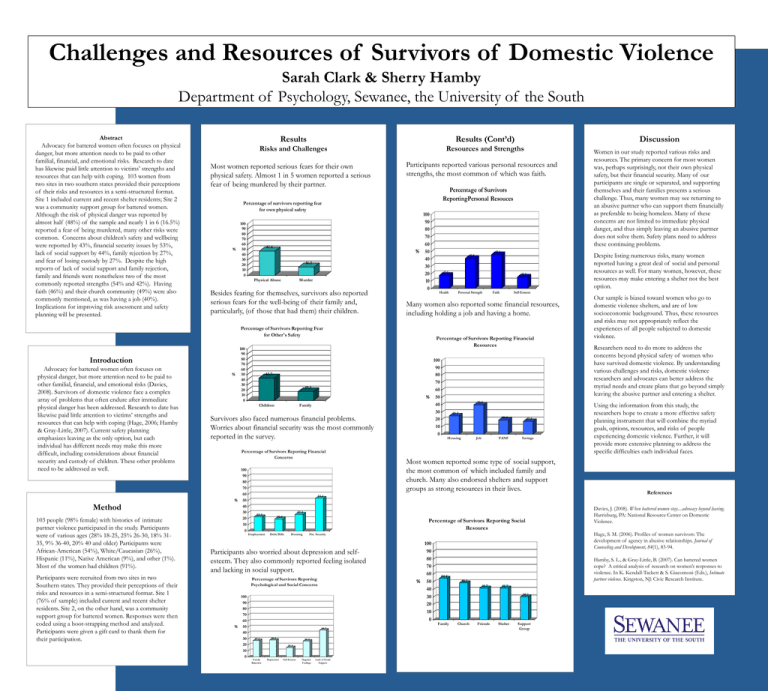
Challenges and Resources of Survivors of Domestic Violence Sarah Clark & Sherry Hamby Department of Psychology, Sewanee, the University of the South Abstract Advocacy for battered women often focuses on physical danger, but more attention needs to be paid to other familial, financial, and emotional risks. Research to date has likewise paid little attention to victims’ strengths and resources that can help with coping. 103 women from two sites in two southern states provided their perceptions of their risks and resources in a semi-structured format. Site 1 included current and recent shelter residents; Site 2 was a community support group for battered women. Although the risk of physical danger was reported by almost half (48%) of the sample and nearly 1 in 6 (16.5%) reported a fear of being murdered, many other risks were common. Concerns about children’s safety and wellbeing were reported by 43%, financial security issues by 53%, lack of social support by 44%, family rejection by 27%, and fear of losing custody by 27%. Despite the high reports of lack of social support and family rejection, family and friends were nonetheless two of the most commonly reported strengths (54% and 42%). Having faith (46%) and their church community (49%) were also commonly mentioned, as was having a job (40%). Implications for improving risk assessment and safety planning will be presented. Results Results (Cont’d) Risks and Challenges Resources and Strengths Most women reported serious fears for their own physical safety. Almost 1 in 5 women reported a serious fear of being murdered by their partner. Percentage of survivors reporting fear for own physical safety % 100 90 80 70 60 50 40 30 20 10 0 47.6 16.5 Physical Abuse Murder Besides fearing for themselves, survivors also reported serious fears for the well-being of their family and, particularly, (of those that had them) their children. Participants reported various personal resources and strengths, the most common of which was faith. Percentage of Survivors ReportingPersonal Resouces 100 90 80 70 60 % 50 40 30 20 10 0 Introduction Advocacy for battered women often focuses on physical danger, but more attention need to be paid to other familial, financial, and emotional risks (Davies, 2008). Survivors of domestic violence face a complex array of problems that often endure after immediate physical danger has been addressed. Research to date has likewise paid little attention to victims’ strengths and resources that can help with coping (Hage, 2006; Hamby & Gray-Little, 2007). Current safety planning emphasizes leaving as the only option, but each individual has different needs may make this more difficult, including considerations about financial security and custody of children. These other problems need to be addressed as well. Method 103 people (98% female) with histories of intimate partner violence participated in the study. Participants were of various ages (28% 18-25, 25% 26-30, 18% 3135, 9% 36-40, 20% 40 and older) Participants were African-American (54%), White/Caucasian (26%), Hispanic (11%), Native American (9%), and other (1%). Most of the women had children (91%). Participants were recruited from two sites in two Southern states. They provided their perceptions of their risks and resources in a semi-structured format. Site 1 (76% of sample) included current and recent shelter residents. Site 2, on the other hand, was a community support group for battered women. Responses were then coded using a boot-strapping method and analyzed. Participants were given a gift card to thank them for their participation. % 43.7 Faith Self-Esteem 70 17.5 60 % 50 39.8 40 Family 30 20 25.2 19.4 17.5 10 0 Housing Job TANF Savings Most women reported some type of social support, the most common of which included family and church. Many also endorsed shelters and support groups as strong resources in their lives. 53.4 27.2 23.3 Employment 19.4 Percentage of Survivors Reporting Social Resoures Debt/Bills Housing Percentage of Survivors Reporting Psychological and Social Concerns 100 90 80 70 60 50 40 44.7 27.2 28.2 26.2 15.5 Family Rejection Depression Self-Esteem Negative Feelings Lack of Social Support 100 90 80 70 60 % 50 40 30 20 10 0 Our sample is biased toward women who go to domestic violence shelters, and are of low socioeconomic background. Thus, these resources and risks may not appropriately reflect the experiences of all people subjected to domestic violence. Researchers need to do more to address the concerns beyond physical safety of women who have survived domestic violence. By understanding various challenges and risks, domestic violence researchers and advocates can better address the myriad needs and create plans that go beyond simply leaving the abusive partner and entering a shelter. Using the information from this study, the researchers hope to create a more effective safety planning instrument that will combine the myriad goals, options, resources, and risks of people experiencing domestic violence. Further, it will provide more extensive planning to address the specific difficulties each individual faces. References Davies, J. (2008). When battered women stay....advocacy beyond leaving. Harrisburg, PA: National Resource Center on Domestic Violence. Hage, S. M. (2006). Profiles of women survivors: The development of agency in abusive relationships. Journal of Counseling and Development, 84(1), 83-94. Fin. Security Participants also worried about depression and selfesteem. They also commonly reported feeling isolated and lacking in social support. 10 0 Personal Strength 90 80 Percentage of Survivors Reporting Financial Concerns 30 20 Health 15.5 Percentage of Survivors Reporting Financial Resources Survivors also faced numerous financial problems. Worries about financial security was the most commonly reported in the survey. % 17.5 Women in our study reported various risks and resources. The primary concern for most women was, perhaps surprisingly, not their own physical safety, but their financial security. Many of our participants are single or separated, and supporting themselves and their families presents a serious challenge. Thus, many women may see returning to an abusive partner who can support them financially as preferable to being homeless. Many of these concerns are not limited to immediate physical danger, and thus simply leaving an abusive partner does not solve them. Safety plans need to address these continuing problems. Despite listing numerous risks, many women reported having a great deal of social and personal resources as well. For many women, however, these resources may make entering a shelter not the best option. 100 Children 100 90 80 70 60 % 50 40 30 20 10 0 45.6 40.8 Many women also reported some financial resources, including holding a job and having a home. Percentage of Survivors Reporting Fear for Other's Safety 100 90 80 70 60 50 40 30 20 10 0 Discussion Hamby, S. L., & Gray-Little, B. (2007). Can battered women cope? A critical analysis of research on women’s responses to violence. In K. Kendall-Tackett & S. Giacomoni (Eds.), Intimate partner violence. Kingston, NJ: Civic Research Institute. 54.4 48.5 41.7 41.7 30.1 Family Church Friends Shelter Support Group
